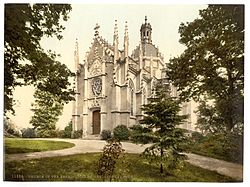St Michael's Abbey, Farnborough

St. Michael's Abbey Church
|
|
| Monastery information | |
|---|---|
| Other names | Farnborough Abbey |
| Order | Benedictine |
| Established | 1881 |
| Dedicated to | St. Michael |
| Diocese | Portsmouth |
| Controlled churches | St. Michael's Abbey Church |
| People | |
| Founder(s) | Eugénie de Montijo |
| Abbot | Dom Cuthbert Brogan |
| Important associated figures | |
| Site | |
| Location | Farnborough, Hampshire, United Kingdom |
| Coordinates | 51°17′48″N 0°45′00″W / 51.2968°N 0.7499°WCoordinates: 51°17′48″N 0°45′00″W / 51.2968°N 0.7499°W |
| Grid reference | SU873560 |
| Public access | Yes |
Saint Michael's Abbey (French: Abbaye Saint-Michel) is a Benedictine abbey in Farnborough, Hampshire, England. The small community is known for the quality of its liturgy, which is sung in Latin and Gregorian Chant, its pipe organ, and its liturgical publishing and printing. It is also the national shrine of St Joseph. Public tours of the Abbey take place every Saturday at 3pm, with the tour comprising a tour of the church and a visit to the crypt. Organ recitals are held on the first Sunday afternoon of the month between May and October at 3pm.
Following the fall of the Second French Empire in 1870, Napoleon III (1808–1873), his wife Empress Eugénie (1826–1920) and their son the Prince Imperial (1856–1879) were exiled from France and took up residence in Chislehurst, England, where Napoleon III died in 1873. He was originally buried at St Mary's Catholic Church, Chislehurst, but, following the death of the Prince Imperial in 1879, the grief-stricken Eugénie set about building a monument to her family. She founded the abbey in 1881 as a mausoleum for her husband and son, wishing that the burial place should be a place of prayer and silence. The Abbey included an Imperial Crypt, modelled on the altar of St Louis in France, where the Emperor had originally desired to be buried., where Eugénie was later buried alongside her husband and son. All three rest in granite sarcophagi provided by Queen Victoria. The Abbey Church itself was designed in an eclectic flamboyant gothic style by the renowned French architect Gabriel-Hippolyte Destailleur and contains the thigh bone of St Alban, the largest relic of the saint in England.
...
Wikipedia

